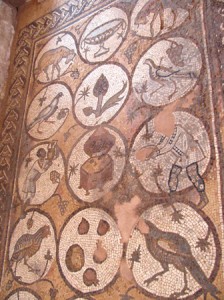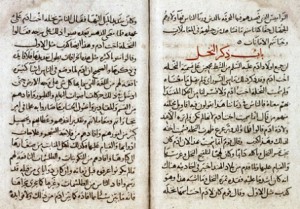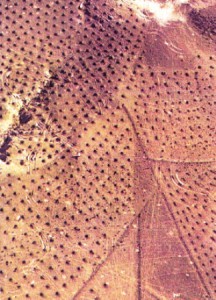Irish botanists are using fungi that grow on cattle and sheep dung to study the history of farming in the Burren. Interesting enough in its own right, but it also reminded me that coprophagus organisms have been used in another part of the world, to the same end.
Documenting the farming transition around the world
Two recent papers shed light on that grey area where hunter-gatherers become farmers. From northern China, archaeological evidence is showing that 8,000 years ago it was highly mobile foraging bands interested in feeding not only themselves but also, interestingly, their hunting dogs, who in effect invented millet — that’s broomcorn millet (Panicum miliaceum) and foxtail millet (Setaria italica) — cultivation. This was later taken up and intensified by what are known as the Late Banpo Phase millet agriculturalists.
A thousand years previously, and half a world away, archaeological, paleoecological, linguistic and genetic data from the SW United States seems to suggest that “maize moved northward from central Mexico to [the] Southwest by being passed from one hunter-gatherer band to the next, who incorporated the crop into their subsistence economies and eventually became farmers themselves.” Not, that is, as a result of the movement of Mexican agriculturalists, which was the alternative scenario. Nothing to do with feeding their livestock in this case, though. Turkeys seem to have been domesticated much later.
Locating agricultural origins in Mexico and Italy
I know that domestication is not an event, but a process. I know that most crops and livestock were probably domesticated more than once, in more than one area. I know all this, but I’m still a sucker for papers that come up with specific times and places for the origin of agriculture. Papers such as Daniel Zizumbo-Villarreal and Patricia Colunga-GarcíaMarín‘s in the latest GRACE:
Sympatric distribution of the putative wild ancestral populations of maize, beans and squash indicate the extreme northwest Balsas-Jalisco region as a possible locus of domestication.
The paper is a review. It synthesizes a host of paleoecological, archaeobotanical and molecular data. Meanwhile, another paper, this time in the Journal of Archaeological Science, applies matrix mathematics to a somewhat different, though related, problem: the arrival of wheat in Italy. The authors looked at a selection of old emmer landraces from all around Italy stored in the German and ICARDA genebanks. 1 They developed a matrix of genetic distances among these based on microsatellite data. They then calculated matrices of geographical distances among the landraces based on different putative places of arrival of the crop around the coast of Italy. The two matrices showed the closest correlations for arrival sites located in northern Puglia, the heel of Italy. That corresponds with where the earliest Neolithic sites are found.
Now, I wonder, when will someone apply this method to maize, beans and squash molecular data and test mathematically Zizumbo-Villarreal and Colunga-GarcíaMarín more “qualitative” inferences?
Nibbles: Sequencing, Agricultural origins, Mating systems, Tomato shelf-life, Beer vs Tea, Soy, Carrot, Seed processing, Screw-pine, Yams, Salicornia, Pollinators
- Second generation sequencing on the one hand. First generation methylation mapping on the other. What’s a poor bitechnologist to do?
- Site of the birth of MesoAmerican agriculture pinpointed.
- Meta-analysis says mating system does not affect magnitude of local adaptation. Ok, I really need to understand this one, because it’s kinda counter-intuitive..
- Boffins produce longer-lasting tomato. Which, however, still tastes like water. Those pesky biotechnologists are all over this.
- A tale of two brews. And here’s why I prefer beer. Well, one reason. Meanwhile, a hero probes how the amber nectar comes to be.
- Another slightly dubious use for soy. Aren’t you glad its genome has been sequenced? Thanks, Jacob.
- Evidence for cultivated carrot from medieval Poland. I’m sure this is REALLY important.
- CIMMYT video of seed processing.
- Pandanus photo for all my Pacific friends.
- Yams to have their day? I hope so, but we have been here before. Repeatedly.
- Salicornia the new hope for saline regions? I hope so, but we have been here before. Repeatedly.
- FAO manages wild biodiversity to manage pollinators.
What did the Nabateans grow?
You know how the internet is. Endless rabbit holes down which to lose oneself. Some questions answered. Others, not so much. New ones arise. Here’s an example. It all started with the Mosaic of the Seasons in the 5th century Byzantine church at Petra in Jordan. I visited the site last week and thought the agrobiodiversity-themed mosaics wonderful.

That got me thinking about Nabatean crops more generally. What did these people grow in the middle of the desert? Did it include the plants depicted in these mosaics? The Nabateans were known as spice (and incense) traders, but more as middlemen rather than actual producers. Why, indeed, did they find it necessary to grow anything at all in such a harsh environment? Couldn’t they have traded for everything they needed, sitting astride a major trade route from the East to Rome?
So I googled a bit, and it turns out there’s a book called Nabatean Agriculture. Or Al-Filahah al-Nabatiyah in fact, written by a 9th century Mesopotamian scholar called Ibn Wahshiyah. Unfortunately, though the Arabic text is online, I could not find anything that I could actually read on the contents of the book beyond that it includes “a wealth of knowledge on the preparation of basic foods from the agricultural products mentioned throughout the book.” Frustrating.

However, I did find an enormous amount on the sophisticated water management practices of the Nabateans, for example in the supporting document to Israel’s proposal for inscription of the “Desert Cities of the Negev” as a World Heritage Site. It’s a huge pdf, so watch out, but it does have great descriptions, starting on page 108, of the channels, damns and cisterns these communities built to save and manage water in a region with less that 100mm of annual rainfall. Some of these practices are in fact being revived. One consists of enigmatic piles of rocks called tuleilat el anab in Arabic, which means “grape mounds.” 2

They measure 1 m in diameter by 30 cm in height and in some places extend for several square kilometers. So it’s not just pleasure gardens we’re talking about. The prevailing view seems to be that the grape mounds were intended to enhance the flow of run-off water into agricultural terraces. Their name is the only clue to the crops grown by the Nabateans that I’ve been able to find 3, apart maybe for those mosaics. There must surely be some archaeobotanical evidence somewhere? More rabbit holes beckon.